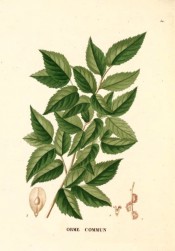Ulmus procera Salisb.
Fully hardy, large, broadly upright, deciduous tree with ovate, toothed leaves, to 10cm long, turning yellow in autumn, and tiny red flowers in spring, followed by winged green fruit, to 1.5cm across, rarely produced. It spreads mainly through suckers. To 40m. [RHSE, Hortus, Hilliers’].
Horticultural & Botanical History
An ancient plant of parks and gardens in Europe. This species is not suited to the Camden climate and rarely thrives. ‘U. campestris, L. The Common Elm of Europe. It extends to North Africa. See t.232 of Bentley and Trimen’s “Medicinal Plants.” The Common Elm does very well in Melbourne and Adelaide; it succeeds far less in Sydney. In Europe it is very abundant, being used both in parks and for street and avenue planting. The timber of the Elm is tough, and remarkably durable under water. It was formerly employed in making water-pipes before these were superseded by iron ones. Coffins are commonly made of it in Europe. The dried inner bark is official in the British Pharmacopaeia, possessing mild astringent tonic and demulcent properties.’ [Agricultural Gazette of NSW p.782/1908]. This article is accompanied by two photographs of young English elms growing at the State nursery at Campbelltown, a few kilometers from Camden.
Figured in Saint-Hilaire Arb. pl.50/1824.
History at Camden Park
Listed in all published catalogues but no longer present in the gardens [T.978/1843].
Notes
Published Feb 28, 2010 - 02:34 PM | Last updated Aug 01, 2010 - 03:03 PM
| Family | Ulmaceae |
|---|---|
| Category | |
| Region of origin | England, Europe to north Africa |
| Synonyms |
|
| Common Name | English elm, Common elm |
| Name in the Camden Park Record |
Ulmus campestris - English elm |
| Confidence level | high |
